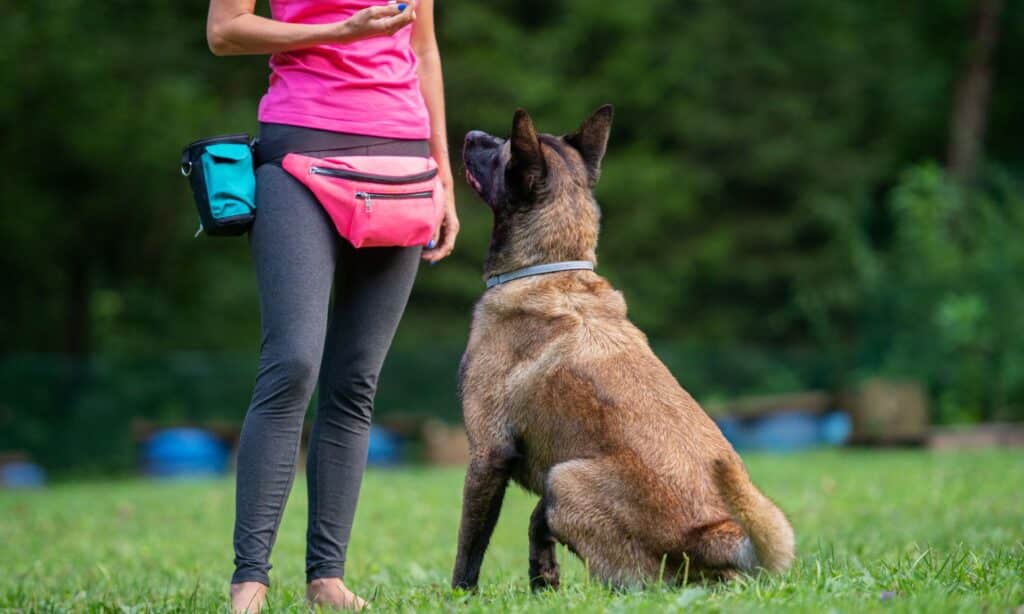
Caring for a pet with imaginative and prescient loss and sudden blindness is horrifying for each you and your greatest good friend. Crucial factor you are able to do is educate your self on the underlying causes of your pet’s altering imaginative and prescient, assist them adapt to a life with restricted eyesight, and learn to assist your canine reside with out sight.
Indicators of Pet Blindness
Relying on what induced your canine’s imaginative and prescient loss, they might have misplaced their imaginative and prescient in a single day or had their imaginative and prescient diminish slowly over time. Understanding the indicators of pet blindness will help you to note the medical indicators a lot earlier. The most typical indicators your canine’s eyesight is altering embody:
- Bumping into furnishings, hitting their head on the wall, or struggling to navigate the home
- Reluctance to leap off furnishings
- Hesitancy to go down the steps, particularly when the lights are off
- Unable to discover a toy or ball when it’s thrown, or being fully unaware while you throw a toy
- Startled in shiny mild
- Extreme thirst or extra frequent urination
- Cloudy eyes
Any pet experiencing a number of of those signs ought to be examined by their veterinarian instantly. The sooner your pet’s imaginative and prescient loss is detected, the extra treatable it may be and the higher you possibly can assist them adapt.
5 Causes of Imaginative and prescient Loss in Canines & Cats
Many various eye circumstances could cause a change in your pet’s imaginative and prescient. Subsequently, how your pet’s imaginative and prescient loss is handled is dependent upon their eye situation. The most typical causes of sudden imaginative and prescient loss in pets embody:
1. SARDS or Sudden Acquired Retinal Degeneration
SARDS is a degenerative eye situation that comes on rapidly and may end up in full blindness. Most pets with SARDS can be fully blind inside 24 hours to a month of prognosis.
SARDS Signs
- Sudden blindness
- Eye irritation or rare blinking
- Pupil dilation
- Little to no response to mild
- Elevated thirst and urge for food (with noticeable weight acquire)
Canine Breeds at Danger for SARDS
Most frequently occurring in feminine canine, most canine recognized with SARDS are between the ages of 6 to 14 years previous. Breeds mostly affected by SARDS are:
- Beagle
- Dachshund
- Schnauzer
- Pug
- Brittany Spaniel
- Maltese
SARDS causes irreversible imaginative and prescient loss. Though there is no such thing as a remedy for canine SARDS, it is not going to have an effect on a canine’s life expectancy. In a medical examine of canine with SARDS 95% of the pet dad and mom surveyed believed that their canine had a great high quality of life and would discourage euthanasia on account of a SARDS prognosis. Though a pet with SARDS can be blind for the remainder of its life, it is going to reside an in any other case completely happy and wholesome life.
Earlier than & After a Blind Canine with SARDS Tries a Halo
2. Glaucoma
This painful eye situation typically happens in a single eye first. Glaucoma is a painful build-up of eye strain that kills and damages retinal cells and optic nerve. Ultimately, the strain will result in canine imaginative and prescient loss.
Glaucoma Signs in Canines
- Swollen eyes, eyes could seem to bulge outwards
- Indicators of eye ache, together with rubbing or digging at eyes
- Pet avoids having head touched
- Cloudy eyes
- Lethargy
Canine Breeds Vulnerable to Glaucoma

- Boston Terrier
- Basset Hound
- Shar-pei
- Cocker Spaniel
- Siberian Husky
- Labrador Retriever
When caught early, a canine can get better, nevertheless most pet dad and mom miss the medical indicators of glaucoma till it’s too late to alleviate the attention strain. Solely 50% of canine who obtain medical care will regain their eyesight.
3. Progressive Retinal Atrophy or PRA
An inherited situation, PRA causes retina deterioration and blindness in canine. PRA isn’t a painful eye situation. Nevertheless, it does impression each eyes. Most canine with progressive retinal atrophy will lose their eyesight slowly, normally over months or years.
Indicators of Progressive Retinal Atrophy
- Issue navigating in dim lighting
- Dilated pupils and sluggish response to mild
- Reluctance to go outdoors at night time and lack of night time imaginative and prescient
- Eye cloudiness
- Bumping into partitions, doorways, and furnishings
Canine Breeds Impacted by PRA
- Miniature and toy Poodles
- Cocker Spaniel
- Labrador Retriever
- Cavalier Type Charles Spaniel
- Miniature Schnauzer
Gradual imaginative and prescient loss will enable a canine to regulate to their altering eyesight and its impression on its life. Sadly, this progressive situation is irreversible, and there’s no remedy for PRA. Nevertheless, remedy can decelerate the lack of imaginative and prescient.
4. Canine Cataracts
Whenever you consider a blind canine, you possible consider cloudy eyes. Cataracts are characterised by eye cloudiness behind the canine’s eye lens. Because the lens clouds over, it blocks mild from reaching a canine’s retina and stopping them from seeing. A canine could have cataracts in a single or each eyes, and a cataract can appear to seem in a single day.
Scientific Indicators of Cataracts in Canines
- Cloudy eye
- Modifications in eye colour or form of pupil
- A haze over certainly one of each eyes
Canine Breeds with Cataracts

- Boston Terrier
- Cocker Spaniel
- Labrador Retriever
- Poodle
- Husky
- French Bulldog
It’s essential to notice that canine with diabetes are at excessive danger for cataracts no matter breed. Most diabetic canine may have cataracts inside a yr of turning into a diabetic. Not solely are canine with diabetes more likely to have cataracts, however they can even develop in a short time. It’s doable to have canine cataracts eliminated via surgical procedure. Work along with your veterinarian to find out in case your canine is a candidate for cataract surgical procedure.
5. Retinal Detachment
Sudden retinal detachment is the main explanation for blindness in cats however may also happen in canine. Retinal detachment most frequently happens from trauma however may also occur when a pet has hypertension. Partial reattachment could also be doable if the pet’s blood strain is rapidly managed by remedy and introduced again to regular ranges.




